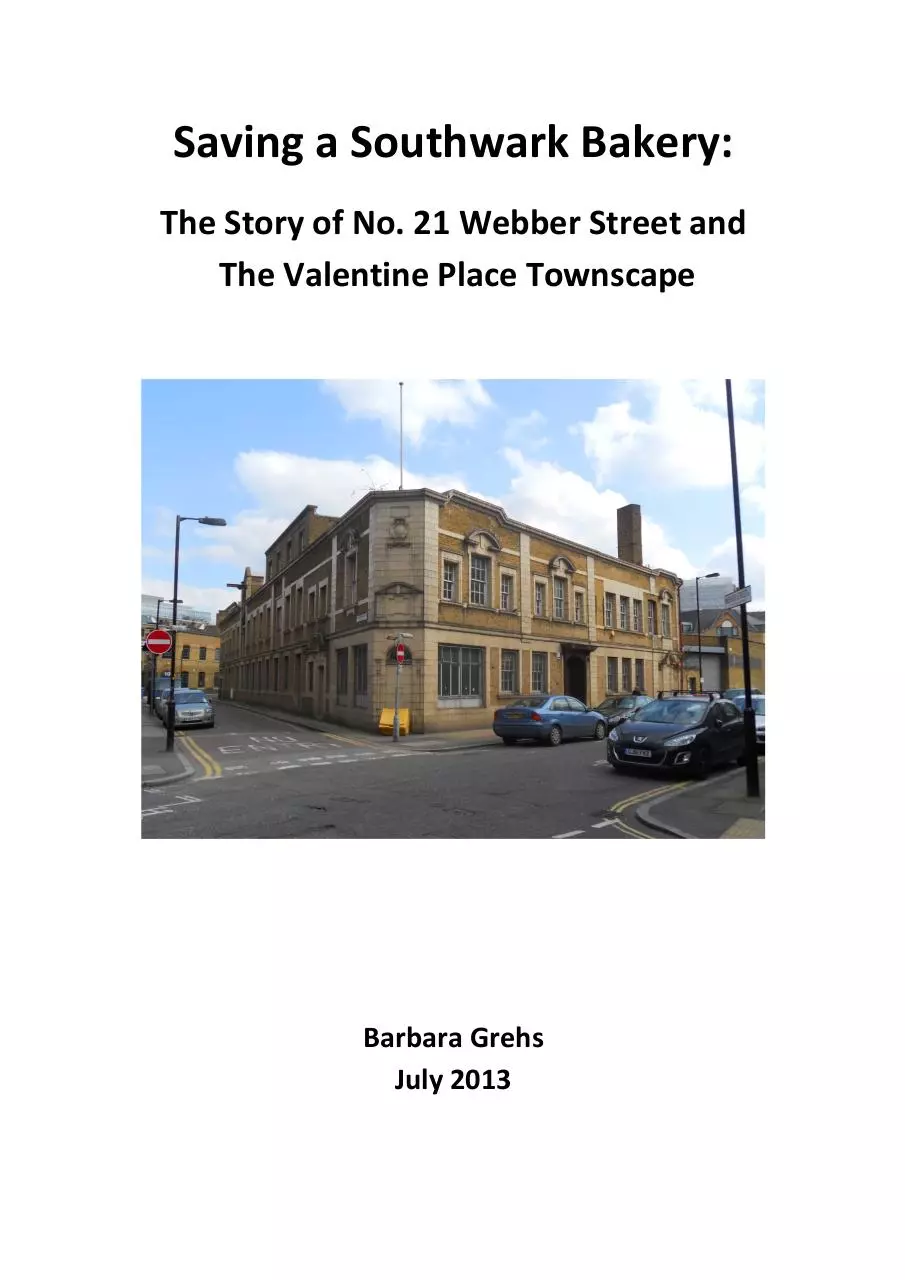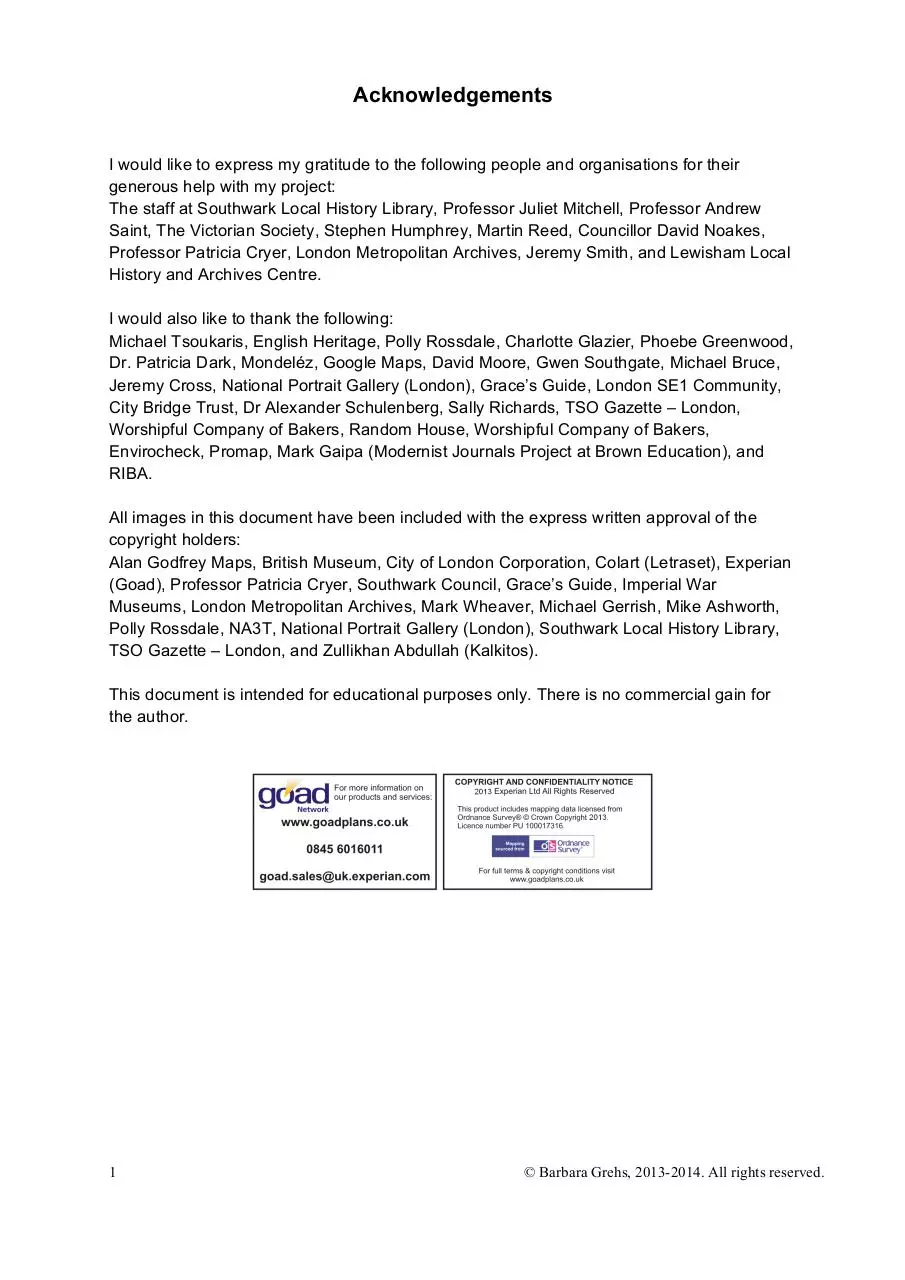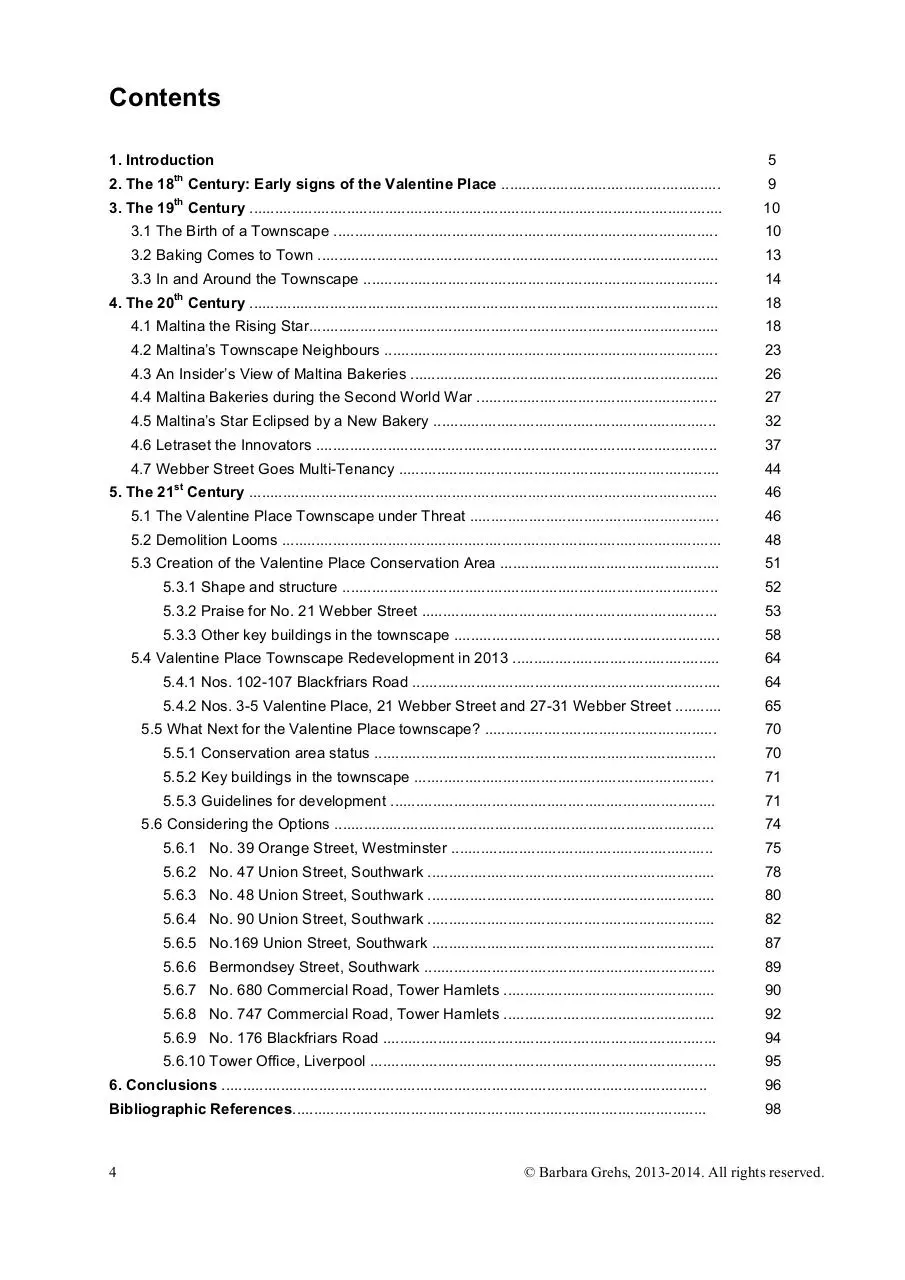21 Webber Street History FINAL PDF 1 Mar 14 (PDF)
File information
Title: 21 Webber Street History FINAL Word docx 1 Mar 14
Author: Barbara Grehs
This PDF 1.4 document has been generated by Word / Mac OS X 10.9.5 Quartz PDFContext, and has been sent on pdf-archive.com on 03/01/2015 at 16:15, from IP address 94.119.x.x.
The current document download page has been viewed 1894 times.
File size: 31.08 MB (111 pages).
Privacy: public file





File preview
Saving a Southwark Bakery:
The Story of No. 21 Webber Street and
The Valentine Place Townscape
Barbara Grehs
July 2013
Acknowledgements
I would like to express my gratitude to the following people and organisations for their
generous help with my project:
The staff at Southwark Local History Library, Professor Juliet Mitchell, Professor Andrew
Saint, The Victorian Society, Stephen Humphrey, Martin Reed, Councillor David Noakes,
Professor Patricia Cryer, London Metropolitan Archives, Jeremy Smith, and Lewisham Local
History and Archives Centre.
I would also like to thank the following:
Michael Tsoukaris, English Heritage, Polly Rossdale, Charlotte Glazier, Phoebe Greenwood,
Dr. Patricia Dark, Mondeléz, Google Maps, David Moore, Gwen Southgate, Michael Bruce,
Jeremy Cross, National Portrait Gallery (London), Grace’s Guide, London SE1 Community,
City Bridge Trust, Dr Alexander Schulenberg, Sally Richards, TSO Gazette – London,
Worshipful Company of Bakers, Random House, Worshipful Company of Bakers,
Envirocheck, Promap, Mark Gaipa (Modernist Journals Project at Brown Education), and
RIBA.
All images in this document have been included with the express written approval of the
copyright holders:
Alan Godfrey Maps, British Museum, City of London Corporation, Colart (Letraset), Experian
(Goad), Professor Patricia Cryer, Southwark Council, Grace’s Guide, Imperial War
Museums, London Metropolitan Archives, Mark Wheaver, Michael Gerrish, Mike Ashworth,
Polly Rossdale, NA3T, National Portrait Gallery (London), Southwark Local History Library,
TSO Gazette – London, and Zullikhan Abdullah (Kalkitos).
This document is intended for educational purposes only. There is no commercial gain for
the author.
1
© Barbara Grehs, 2013-2014. All rights reserved.
Foreword
When I moved to Cathedrals Ward in 1990 after living in many different parts of London, I felt
an intense connection with the area. It took me several years to realise that its strong sense
of community reminded me of my childhood growing up in Newcastle upon Tyne. It is
therefore quite ironic that the comment I hear most often when asked where I live is,
“Waterloo? Really? I didn’t think anyone actually lived there.”
I love living in Southwark and am constantly surprised by how many of its buildings of
obvious architectural and historic note are unresearched and unprotected. I am not antidevelopment and I accept that London is a city of ever-changing needs; that said, the nature
of the extensive regeneration in Cathedrals Ward in the last 15 years – focusing on new build
hotels, office space, student accommodation and premium-priced luxury flats – has led to the
loss of a number of period buildings and a steady erosion of the mixed urban communities
that make this part of London so unique. If Cathedrals Ward is to have any chance of
remaining a place of visible architectural and social heritage and where people from all walks
of life can continue to afford to live, the balance between new and existing builds needs to be
urgently redressed.
In 2010 a much-loved former Victorian warehouse in the Valentine Place townscape close to
where I live was suddenly and unexpectedly demolished over a period of just a few days. Its
loss caused a huge outburst of local feeling and ever since I have found myself barely able
to walk past the remaining gap site without feeling an incredible sense of sadness. So when
a further building in the townscape - the former Edwardian bakery and printworks at No. 21
Webber Street - also came under threat of demolition in 2011, I became part of a group of
residents and local business owners who mounted an intensive campaign to save the
building. We were supported in our efforts by leading experts in architecture and history and
by local councillors, and the outcome of all this hard work was the creation of the Valentine
Place Conservation Area in 2012.
It is often assumed by the general public that conservation area status provides protection
for buildings. In reality, however, demolition and/or major redevelopment can and do occur:
all that is required is planning approval from the local council. Three remaining buildings of
scale in the Valentine Place townscape are owned by the same company which demolished
the former Victorian warehouse on the site in 2010, and the submission of a planning
application for a major redevelopment of these buildings is expected any day now. The aim
2
© Barbara Grehs, 2013-2014. All rights reserved.
of this illustrated document is therefore to provide a comprehensive, fact-based account
focusing primarily on the fascinating history of No. 21 Webber Street and the contribution it
has made to Southwark’s architectural and industrial heritage. Having traced its history and
that of its predecessors in the Valentine Place townscape back to the 1880s, I believe No. 21
Webber Street to be an outstanding period building which is worthy of retention not simply in
its façade, but also in its entire external structure, and that an independent survey should be
carried out to ascertain how much of its interior can be retained. Moreover, No. 21 Webber
Street is not the only building to make a valuable contribution to the townscape: the Victorian
warehouse at Nos. 3-5 Valentine Place has an industrial history and architectural design
which makes it also worthy of retention.
Additional factors which underpin my argument for retention of these period buildings are
Southwark Council’s own official guidelines on how development should be approached in
the townscape and in particular the need for retention of its period warehouses, and the
many examples I have provided in this study of successfully restored period buildings as
evidence of the possibilities which exist for restoring No. 21 Webber Street and Nos. 3-5
Valentine Place to their former glory.
This study has been seven months in the making. I have funded the project myself and spent
countless hours of my spare time researching, writing, photographing buildings and seeking
permissions from copyright holders. There is no commercial gain involved for me and there
never will be: my hope is simply that my work will be of educational interest to libraries, local
residents and businesses, Southwark Council, local councillors, social historians and
architectural experts, and that my findings will help to save as much of this historic
Southwark townscape as possible.
Barbara Grehs
July 2013
3
© Barbara Grehs, 2013-2014. All rights reserved.
Contents
1. Introduction
5
th
9
th
10
2. The 18 Century: Early signs of the Valentine Place ....................................................
3. The 19 Century ................................................................................................................
3.1 The Birth of a Townscape ...........................................................................................
10
3.2 Baking Comes to Town ...............................................................................................
13
3.3 In and Around the Townscape ....................................................................................
14
th
4. The 20 Century ...............................................................................................................
18
4.1 Maltina the Rising Star.................................................................................................
18
4.2 Maltina’s Townscape Neighbours ...............................................................................
23
4.3 An Insider’s View of Maltina Bakeries .........................................................................
26
4.4 Maltina Bakeries during the Second World War .........................................................
27
4.5 Maltina’s Star Eclipsed by a New Bakery ...................................................................
32
4.6 Letraset the Innovators ...............................................................................................
37
4.7 Webber Street Goes Multi-Tenancy ............................................................................
44
st
5. The 21 Century ...............................................................................................................
46
5.1 The Valentine Place Townscape under Threat ...........................................................
46
5.2 Demolition Looms ........................................................................................................
48
5.3 Creation of the Valentine Place Conservation Area ....................................................
51
5.3.1 Shape and structure .........................................................................................
52
5.3.2 Praise for No. 21 Webber Street ......................................................................
53
5.3.3 Other key buildings in the townscape ...............................................................
58
5.4 Valentine Place Townscape Redevelopment in 2013 .................................................
64
5.4.1 Nos. 102-107 Blackfriars Road .........................................................................
64
5.4.2 Nos. 3-5 Valentine Place, 21 Webber Street and 27-31 Webber Street ...........
65
5.5 What Next for the Valentine Place townscape? .......................................................
70
5.5.1 Conservation area status .................................................................................
70
5.5.2 Key buildings in the townscape .......................................................................
71
5.5.3 Guidelines for development .............................................................................
71
5.6 Considering the Options ..........................................................................................
74
5.6.1 No. 39 Orange Street, Westminster ..............................................................
75
5.6.2 No. 47 Union Street, Southwark ....................................................................
78
5.6.3 No. 48 Union Street, Southwark ....................................................................
80
5.6.4 No. 90 Union Street, Southwark ....................................................................
82
5.6.5 No.169 Union Street, Southwark ...................................................................
87
5.6.6 Bermondsey Street, Southwark .....................................................................
89
5.6.7 No. 680 Commercial Road, Tower Hamlets ..................................................
90
5.6.8 No. 747 Commercial Road, Tower Hamlets ..................................................
92
5.6.9 No. 176 Blackfriars Road ...............................................................................
94
5.6.10 Tower Office, Liverpool ..................................................................................
95
6. Conclusions ...................................................................................................................
96
Bibliographic References..................................................................................................
98
4
© Barbara Grehs, 2013-2014. All rights reserved.
1. Introduction
The Valentine Place Conservation Area is situated in Cathedrals ward in the north-western
corner of the London Borough of Southwark. The area is a historic cohesive townscape lying
between Blackfriars Road to the east, Boundary Row to the north, Webber Street to the west
and Valentine Row to the south.
The conservation area comprises the following buildings: Nos. 1-8 Boundary Row; No. 2
Pontypool Place; No. 12 Valentine Place; Nos. 2-10 Valentine Place; a gap site (formerly No.
1 Valentine Place, a Victorian warehouse demolished in 2010); Nos. 3-5 Valentine Place;
Nos. 17/19 (odd) Valentine Place / No. 21 Webber Street; Nos. 27- 31 Webber Street, and
No. 108 Blackfriars Road.
Aerial view of the Valentine Place Conservation Area
© Google Maps, 2012
The exact demarcation of the conservation area was mapped out on a sketch produced by
Southwark Council in 2012 as part of its investigation into the eligibility of the townscape for
conservation status.
5
© Barbara Grehs, 2013-2014. All rights reserved.
© Southwark Council, 2012
6
© Barbara Grehs, 2013-2014. All rights reserved.
No. 21 Webber Street (National Grid Reference TQ 31614 79745) was constructed in 1907
for Maltina Bakeries. For more than a century, this Edwardian building of stock brick, faience1
materials and neo-classical elements has made a major architectural and industrial
contribution to the Valentine Place townscape, with its own unique story to tell.
No. 21 Webber Street
© Barbara Grehs, 2013
Prior to the building’s construction in 1907, the Blackfriars Flour Mill had been established in
the centre of the Valentine Place townscape as early as the 1880s. This, along with the
founding of the British National Bakery School at the nearby London South Bank University
in 1884, marked the beginning of a long tradition of baking in the area that was to last until
the 1960s. During this time, all of the buildings in the townscape (with the exception of the
1
7
Moulded glazed or unglazed terracotta blocks used structurally or as cladding (Oxford Dictionaries, 2013).
© Barbara Grehs, 2013-2014. All rights reserved.
southside of Boundary Row) survived the intense bombing offensive of Waterloo during the
Second World War.
In 1965, No. 21 Webber Street became home to Letraset Ltd, a company that achieved
worldwide recognition for its invention of highly innovative products for commercial
designers. The printing industry had actually been an integral part of the townscape dating
back to at least the early 1870s: there was a large printing works at Boundary Row
(Ordnance Survey, 1872), which was still in existence 40 years later (Ordnance Survey,
1914); Letraset occupied No. 21 Webber Street from 1965 to 1980; and the long-established
Silverprint company made No. 12 Valentine Place its home from the late 1980s to 2012.
The architectural qualities of No. 21 Webber Street have been acknowledged by leading
experts; moreover, its positioning at the junction of Webber Street and Valentine Place
provides definition and shaping to the Valentine Place townscape as well as a focal point for
northern views into the conservation area (Southwark Council, 2012).
The aim of this illustrated history is to provide a comprehensive fact-based account of the
building’s architectural and historical value and to argue for a complete protection of its entire
fabric. A further key building in the townscape - the former Victorian warehouse at Nos. 3-5
Valentine Place - is also of architectural and historical interest and worthy of retention.
Underpinning the argument for retention of these buildings are Southwark Council’s stated
guidelines on how development should be approached in the townscape and in particular the
need for retention of its period warehouses; and the many examples of successfully restored
period buildings included in this study, which provide solid evidence of the potential for
restoring No. 21 Webber Street and Nos. 3-5 Valentine Place to their former glory.
8
© Barbara Grehs, 2013-2014. All rights reserved.
Download 21 Webber Street History FINAL PDF 1 Mar 14
21 Webber Street History FINAL PDF 1 Mar 14.pdf (PDF, 31.08 MB)
Download PDF
Share this file on social networks
Link to this page
Permanent link
Use the permanent link to the download page to share your document on Facebook, Twitter, LinkedIn, or directly with a contact by e-Mail, Messenger, Whatsapp, Line..
Short link
Use the short link to share your document on Twitter or by text message (SMS)
HTML Code
Copy the following HTML code to share your document on a Website or Blog
QR Code to this page

This file has been shared publicly by a user of PDF Archive.
Document ID: 0000202026.